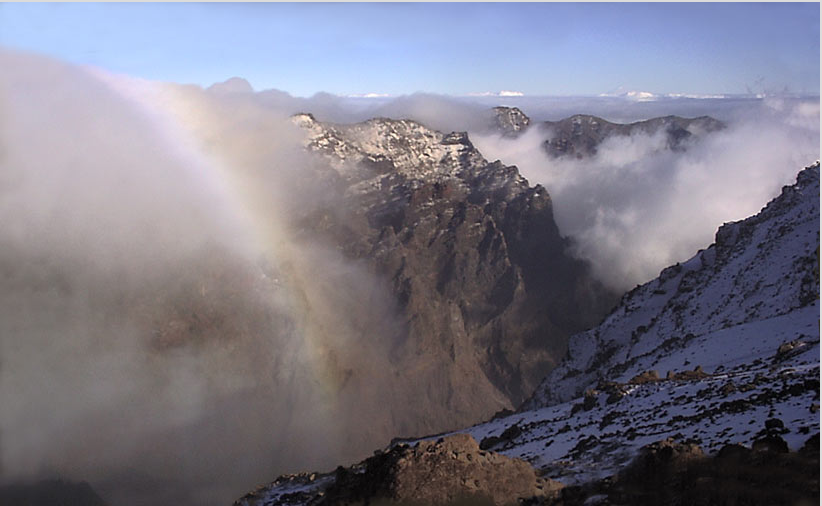Fogbow -
Fogbow - A Spectacular Atmospheric Phenomenon
Have you ever witnessed a fogbow? This captivating atmospheric phenomenon is a close cousin of the more commonly known rainbow. While rainbows occur when sunlight is refracted, reflected, and dispersed by raindrops, fogbows are formed by the same process but with tiny water droplets found in fog. The result is a stunning display of colors against a misty backdrop.
How are Fogbows Formed?
Fogbows are created when sunlight interacts with the small water droplets present in fog. As sunlight passes through these droplets, it is refracted, or bent, and then reflected inside the droplet. This internal reflection causes the light to disperse and form a circular arc of colors. Unlike rainbows, which exhibit a wide range of vibrant hues, fogbows typically appear as faint arcs with pale colors.
The Science Behind the Colors
The colors observed in a fogbow are produced by the same mechanism that creates rainbows: the dispersion of light. When sunlight passes through water droplets, it separates into its component colors due to the different wavelengths of each color. The longer wavelengths, such as red and orange, are bent less than the shorter wavelengths, like blue and violet. This variation in bending angles leads to the distinct color sequence seen in fogbows.
The Unique Appearance of Fogbows
One notable characteristic of fogbows is their lack of vivid colors. Unlike rainbows, which boast an array of vibrant hues, fogbows appear with pastel shades. This subdued coloration is due to the smaller size of water droplets in fog compared to raindrops. The smaller droplets scatter light more efficiently, resulting in less distinct color separation and a washed-out appearance.
The Ghostly White Outer Edge
Fogbows often exhibit a ghostly white outer edge, which adds to their ethereal beauty. This phenomenon occurs because the tiny water droplets in fog diffract light, causing the outer edge of the fogbow to appear brighter. This diffraction effect also contributes to the overall washed-out appearance of fogbows.
The Elusive Red Outer Edge
Under certain atmospheric conditions, fogbows may display a rare and captivating red outer edge. This occurrence, known as a "supernumerary fogbow," is caused by interference between light waves. When the wavelengths of diffracted light align perfectly, constructive interference amplifies the red color, resulting in a stunning and unusual sight.
Fogbows vs. Rainbows
While fogbows and rainbows share similarities in their formation process, there are distinct differences between the two phenomena. Here are some key contrasts:
- Fogbows appear in foggy or misty conditions, while rainbows occur in the presence of raindrops.
- Fogbows have pale colors and lack the vibrant hues seen in rainbows.
- Fogbows are often seen closer to the ground, while rainbows typically appear higher in the sky.
- Fogbows are more commonly observed in mountainous regions or near bodies of water where fog is prevalent.
Where to Spot Fogbows
If you're hoping to catch a glimpse of a fogbow, keep an eye out for foggy or misty conditions. Mountainous areas and coastal regions are particularly favorable for witnessing this atmospheric spectacle. When sunlight peeks through the mist, be sure to look towards the opposite direction to the sun's position. With a bit of luck and patience, you may be rewarded with the enchanting sight of a fogbow gracing the sky.
Capturing the Magic
Photographing a fogbow can be a challenge due to its subtle appearance and the atmospheric conditions required for its formation. However, with the right timing and equipment, it is possible to capture the magic on camera. To enhance your chances of success, consider using a polarizing filter to reduce glare and increase contrast. Additionally, experiment with different angles and compositions to create captivating images of this elusive atmospheric phenomenon.
A Reminder of Nature's Wonders
Fogbows serve as a reminder of the incredible beauty and diversity found in the natural world. These ethereal arcs of pastel colors against a misty backdrop are a testament to the intricacies of light and water droplets. So, the next time you find yourself in a foggy landscape, take a moment to appreciate the enchanting allure of a fogbow, for it is a fleeting reminder of nature's ability to create awe-inspiring spectacles.

Summit of La Palma, Canary Islands. In the locally named "Cascada" effect, clouds pour down the opposite mountain to form an unusually colourful fogbow with distinct golden outer and violet inner edges. Ann Bowker (Mad about Mountains) captured the bow in January 1999.
©Ann Bowker, reproduced with permission.
Note: this article has been automatically converted from the old site and may not appear as intended. You can find the original article here.
Reference Atmospheric Optics
If you use any of the definitions, information, or data presented on Atmospheric Optics, please copy the link or reference below to properly credit us as the reference source. Thank you!
-
<a href="https://atoptics.co.uk/blog/fogbow-3/">Fogbow - </a>
-
"Fogbow - ". Atmospheric Optics. Accessed on April 18, 2024. https://atoptics.co.uk/blog/fogbow-3/.
-
"Fogbow - ". Atmospheric Optics, https://atoptics.co.uk/blog/fogbow-3/. Accessed 18 April, 2024
-
Fogbow - . Atmospheric Optics. Retrieved from https://atoptics.co.uk/blog/fogbow-3/.